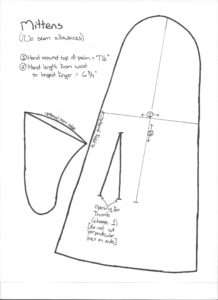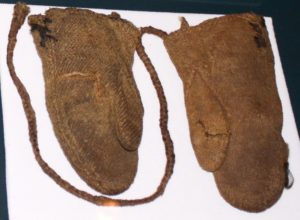As we move toward winter, we must all consider ways to keep warm. Gloves are both a practical accessory to add to you kit and provide an excellent opportunity to make a statement about your persona. Finding the pair that makes just the right statement can be a challenge, but making your own gloves is not as difficult as it may seem. However if you remain intimidated, mittens are a perfectly appropriate alternative for all classes throughout the Middle Ages and Renaissance. Extant mittens, made from both fabric and Nålebinding, have been found dating back well into the Viking Age, and mittens made from a range of materials still exist from the sixteenth century. Check out our Pintrest Page to see some more examples.
Today I’m going to focus on my experience from replicating mittens of the early Middle Ages. The Baltic Knowledge Pages has an article detailing five mittens (one pair of a child’s mittens and three individual mittens for adults) from the early Middle Ages, including drawings of several mittens and a conjectured pattern for the child’s pair. The pattern there works fairly well, but I made modifications to better fit my hands. First, because the pattern is squared around the hand, the final mitten was very loose around my fingers and yet difficult to pull over a sleeve cuff. Since I will be wearing these mittens over several layers of gowns, I need the mittens’ cuffs to be roomy. Tapering the pattern easily accommodated both of these problems. Second, because the seam for the thumb is straight on both the thumb piece and the hand, it pulled the mitten uncomfortably across the width of my hand (this problem is more likely to occur if you have a meaty thumb). Rounding the bottom edge of the thumb piece gave it the necessary give to accommodate my thumbs. Additionally, I tapered the thumb pieces to more closely fit my thumbs and on the final mittens I angled the thumb slit because I found the placement a bit uncomfortable. Finally, I moved the folded edge to the side with the thumb slit so I didn’t have to deal with the seam so close to the thumb.
After making all of these adjustments, my own pattern looked like this:

Your hand may not be the same size or shape as mine, so you will need to adjust the pattern. I have included my own measurements on this pattern as a guide.
All of the mittens from this period were whip-stitched together, some with obvious, contrast threads and others with thread less likely to be seen. None still have a lining, but one mitten seems to have had a woolen pile lining. Like many of my clients, I often find modern wool uncomfortable and itchy, so I added a linen lining to my mittens. The seams were then whip-stitched with fine black thread, resulting in seams invisible to the naked eye. I wanted to add a personal touch, but nothing too bold, so the hem of the mittens is embroidered with heavy black thread in a stepped blanket stitch. I also added ties of the same thread braided into a cord, which I can use to tie the mittens tight around my wrists or pin to my sleeves so I don’t misplace my mittens.
Happy sewing!


